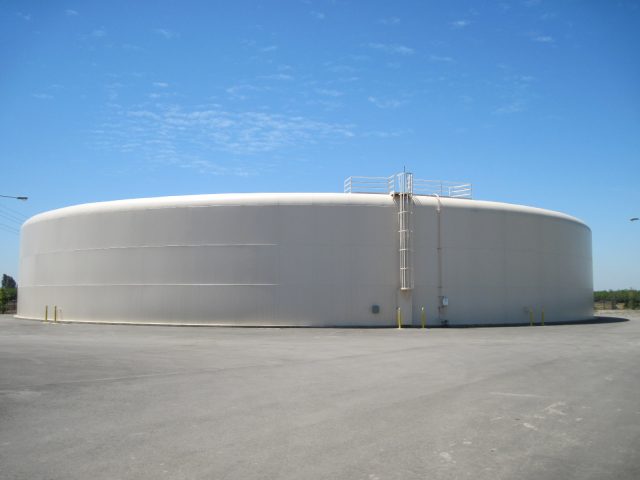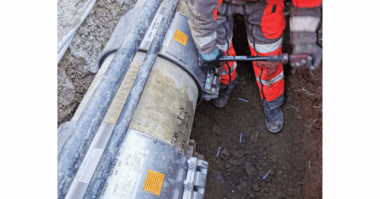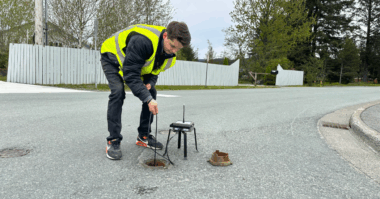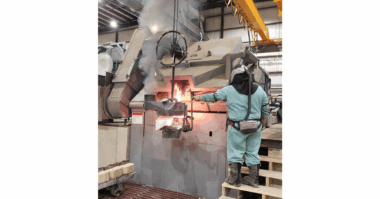The City of Modesto, California is situated 90 miles east of San Francisco and has approximately 200,000 residents relying on 200,000 of gallons of water a day. The City needed to upgrade three water storage tanks that hold approximately 750,000 gallons each.
After years of using motor operated valves to fill water storage tanks, the city recognized that there were just too many problems. Firstly, they had leakage of the stem seals after just a few years of operation. The cause of this problem was due to turbulence in the flow stream that would make the butterfly valve rock back and forth causing premature wear.
Secondly, there was leakage due to high flow turbulence. When you’re flowing wide open on a 16” valve at about 10,000 GPM, there is quite a bit of turbulence, which wears on the stem and seals. If you close the valve slightly to reduce the flow the wear is even worse. If you attempt to regulate flow with a magnetic flowmeter and controller, the valve cycles constantly causing even more wear.
Thirdly there were problems with influent pressure drop during opening, and pressure rise / water hammer when closing because the valves had no adjustment capability to limit the speed of operation. This meant there was marginal flow control, but moreover limit switch and motor contactor failures, were too frequent.
“The bottom line, is for this application, motor operated valves were incorrect and it was time to look for alternative solutions” said Steve Fassio, SCADA Technical Support for City of Modesto.
In order to improve distribution pressure to residential and industrial customers in South Modesto, the city needed replacement fill control valves that had the following capabilities:
- Adjustable flow control
- Adjustable opening and closing speeds (to minimize main line pressure fluctuations)
- Manual override
- Remote control interface to their SCADA system.
The solution they chose to go with was Singer Valves 2SC-MV valve with MV1-TP Electronic Flow Control and Metering. The MV1-TP gave Modesto touch screen control for local operation by providing intuitive connections and terminals that made it easy for the Modesto to connect and integrate to their own control system. The PLC based touch screen controller allows on-screen calibration of process signals, graphic trending displays for valve PID tuning, plus manual or automatic mode selection for testing and maintenance. “This flexible package of controls was just what they needed for their system”, said Dave Burrell of Southwest Valve, exclusive representative for Singer Valve in California.
Eugene Bahia, Instrumentation Technologist for Singer Valve was on site for the start-up to ensure valves were installed correctly, panels wired properly, observe valve and panel operations and simulate failures. During this time Mr. Fassio requested modification of additional filtering functionality on the transmitter signals for stability and also modifications to the touch screen display to make it more intuitive for Modesto Operators. These modifications were made on the spot and took an hour, before placing the valve and panel in full automatic control. “Eugene really knew his technology and was instrumental in commissioning our valves and training our maintenance staff,” said Mr. Fassio.
“The three original valves have been in operation for five years now without one mechanical or electrical failure”, said Mr Fassio. “We have been so pleased with our new system in terms of product quality and service support that we have continued to purchase additional Singer flow control and pressure reducing valves for many applications” concluded Mr. Fassio.
Electronically Controlled Dual Solenoid Control Valve with Hydraulic Pressure Reducing and Sustaining Function on Power Failure
One of these new installs was for a fill control valve on a new 4 million gallon storage tank. In this application, there was another tank in close proximity on the same distribution pipeline. It was crucial that the mainline distribution pressure not be compromised in the event that both tanks attempted to fill at the same time.
Singer Valve’s solution was to add an inlet pressure transmitter that was able to provide a MCP-TP Multi Process Control Panel. This meant that if inlet pressure dropped below an adjustable set-point during filling, the controller would override and modulate (reduce) the flow to that tank until inlet pressure recovers. This upgraded control panel includes all the functions of the original panels with some very important customized control features:
Inlet pressure monitoring and override
This prevents the inlet pressure from dropping too low. If the inlet pressure drops too low, other users and customers in their system will not have enough water for daily use when the Fire Department needs water pressure to fight a fire. It also ensures that the valve does not erroneously open fully when the inlet pressure supply drops low and the setpoint is not reached. If it did, it would likely over flow the tank.
Selectable pressure control, flow control, or level control functionality
The valve and panel, though primarily designed for level control, can also be used for pressure control or flow control if Modesto wanted. No additional programming or changes are required.
Dual diaphragm (PGM) main valve with integral back-up
The integral back-up is fitted with a hydraulic altitude pilot that senses tank overflow. If tank overflow is detected, the valve will close fully regardless of panel command, primary diaphragm failure, primarily pilot system failure, solenoid failure, or plugged strainer.
This now means that during peak summer season demands, Modesto can fill both tanks simultaneously and still maintain a stable mainline pressure.
However, the most important additional feature came about from a near disaster when a City Modesto mechanic happened to be driving by and saw the beginning of the tank overflow. The tank sits in a residential area, so with 10,000 gallons releasing per minute, it would have flooded someone’s house or houses if not detected.
It was determined that there was a momentary loss (about five minutes) of influent pressure to a valve because of a failure in the booster pump system upstream which occurred on one of the old valves. While filling one of the storage tanks, they lost influent. Without sufficient inlet pressure, the differential pressure transmitter cannot calculate flow feedback correctly (it thinks it’s lower than actual). The PID loop in the PLC begins to integrate positive, calling the open pilot solenoid to drain water off the diaphragm. When influent pressure returned, there was no pressure on top of the diaphragm and so the valve was operating almost wide open with no chance of recovery. The only way to stop flow in this case is to manually close an isolation gate valve in order to manually close the valve.
So the additional feature that Singer Valve put in place is an optional dual diaphragm valve chamber with level sensing altitude pilot valve. This ensures a positive mechanical override in the event of an electronic failure. If inlet pressure drops, the valve starts closing to sustain inlet pressure.
“Based on our history of outstanding performance from our previous Singer valves and control panels, I believe I may never use this feature”, said Mr. Fassio of Modesto. “But it still provides our department with additional peace of mind because a storage tank overflow at 5,000 to 10,000 gallons a minute can make quiet a mess,” concluded Mr. Fassio.




